Edward Steichen
Edward Jean Steichen (March 27, 1879 – March 25, 1973) was a Luxembourgish American photographer, painter, and curator, renowned as one of the most prolific and influential figures in the history of photography.[1]
Edward Steichen | |
|---|---|
 Edward Steichen, photographed by Fred Holland Day (1901) | |
| Born | Édouard Jean Steichen March 27, 1879 Bivange/Béiweng, Luxembourg |
| Died | March 25, 1973 (aged 93) |
| Nationality | Luxembourg by birth; United States from 1900 |
| Known for | Photography, Painting |
| Spouses | Clara Smith
(m. 1903; div. 1922)Dana Desboro Glover
(m. 1923; died 1957) |
| Children | Mary Steichen Calderone Charlotte "Kate" Rodina Steichen |
| Relatives | Lilian Steichen (sister) Carl Sandburg (brother-in-law) |
| Awards | Légion d'Honneur, Medal of Freedom |
| Website | edwardsteichen |
Steichen was credited with transforming photography into an art form.[2] His photographs appeared in Alfred Stieglitz's groundbreaking magazine Camera Work more often than anyone else during its publication run from 1903 to 1917. Stieglitz hailed him as "the greatest photographer that ever lived".[3][4]
As a pioneer of fashion photography, Steichen's gown images for the magazine Art et Décoration in 1911 were the first modern fashion photographs to be published. From 1923 to 1938, Steichen served as chief photographer for the Condé Nast magazines Vogue and Vanity Fair, while also working for many advertising agencies, including J. Walter Thompson. During these years, Steichen was regarded as the most popular and highest-paid photographer in the world.[5]
After the United States' entry into World War II, Steichen was invited by the United States Navy to serve as Director of the Naval Aviation Photographic Unit.[6] In 1944, he directed the war documentary The Fighting Lady, which won the Academy Award for Best Documentary Feature at the 17th Academy Awards.
From 1947 to 1961, Steichen served as Director of the Department of Photography at New York's Museum of Modern Art. While there, he curated and assembled exhibits including The Family of Man, which was seen by nine million people. In 2003, the Family of Man photographic collection was added to UNESCO's Memory of the World Register in recognition of its historical value.[7]
In February 2006, a print of Steichen's early pictorialist photograph, The Pond—Moonlight (1904), sold for US$2.9 million—at the time, the highest price ever paid for a photograph at auction.[8] A print of another photograph of the same style, The Flatiron (1904), became the second most expensive photograph ever on November 8, 2022, when it was sold for $12,000,000, at Christie's New York – well above the original estimate of $2,000,000-$3,000,000.[9]
Early life
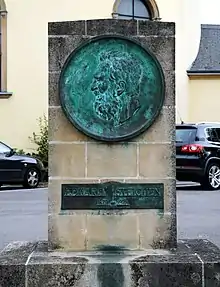

Steichen was born Éduard Jean Steichen on March 27, 1879, in a small house in the village of Bivange, Luxembourg, the son of Jean-Pierre and Marie Kemp Steichen.[10] His parents facing increasingly straitened circumstances and financial difficulties, decided to make a new start and emigrated to the United States when Steichen was eighteen months old. Jean-Pierre Steichen immigrated in 1880, with Marie Steichen bringing the infant Éduard along after Jean-Pierre had settled in Hancock in Michigan's Upper Peninsula copper country. According to noted Steichen biographer, Penelope Niven, the Steichens were “part of a large exodus of Luxembourgers displaced in the late nineteenth century by worsening economic conditions.”[10]
Éduard's sister and only sibling, Lilian Steichen, was born in Hancock on May 1, 1883. She would later marry poet Carl Sandburg, whom she met at the Milwaukee Social Democratic Party office in 1907. Her marriage to Sandburg the following year helped forge a life-long friendship and partnership between her brother and Sandburg.[11][12]
By 1889, when Éduard was 10, his parents had saved up enough money to move the family to Milwaukee.[13] There he learned German and English at school, while continuing to speak Luxembourgish at home.[14]
In 1894, at fifteen, Steichen began attending Pio Nono College, a Catholic boys' high school, where his artistic talents were noticed. His drawings in particular were said to show promise.[15] He quit high school to begin a four-year lithography apprenticeship with the American Fine Art Company of Milwaukee.[16] After hours, he would sketch and draw, and he began to teach himself painting.[17] Having discovered a camera shop near his work, he visited frequently until he persuaded himself to buy his first camera, a secondhand Kodak box "detective" camera, in 1895.[18] Steichen and his friends who were also interested in drawing and photography pooled their funds, rented a small room in a Milwaukee, WI office building, and began calling themselves the Milwaukee Art Students League.[19] The group hired Richard Lorenz and Robert Schade for occasional lectures.[16] In 1899, Steichen's photographs were exhibited in the second Philadelphia Photographic Salon.[20]
Steichen became a U.S. citizen in 1900 and signed the naturalization papers as Edward J. Steichen, but he continued to use his birth name of Éduard until after the First World War.[21]
Career
Paris, New York, and Partnerships with Stieglitz and Rodin
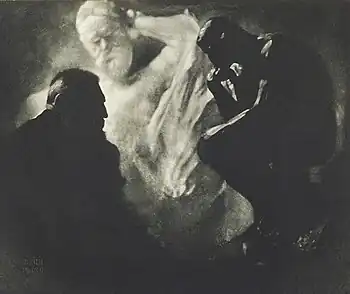
In April 1900, Steichen left Milwaukee for Paris to study art. Clarence H. White thought Steichen and Alfred Stieglitz should meet, and thus produced an introduction letter for Steichen, and Steichen —then en route to Paris from his home in Milwaukee— met Stieglitz in New York City in early 1900.[22] In that first meeting, Stieglitz expressed praise for Steichen's background in painting and bought three of Steichen's photographic prints.[23]
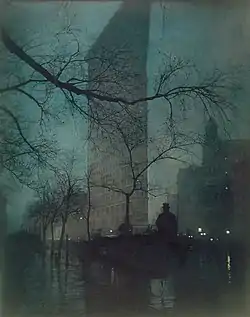
In 1902, when Stieglitz was formulating what would become Camera Work, he asked Steichen to design the logo for the magazine with a custom typeface.[24] Steichen was the most frequently shown photographer in the journal.
Steichen began experimenting with color photography in 1904 and was one of the earliest in the United States to use the Autochrome Lumière process.[25] In 1905, Stieglitz and Steichen created the Little Galleries of the Photo-Secession, in what had been Steichen's portrait studio;[26] it eventually became known as the 291 Gallery after its address. It presented some of the first American exhibitions of Auguste Rodin, Henri Matisse, Paul Cézanne, Pablo Picasso, and Constantin Brâncuși.
According to author and art historian William A. Ewing, Steichen became one of the earliest "jet setters", constantly moving back and forth between Europe and the U.S. by steamship, in the process cross-pollinating art from Europe to the United States, helping to define photography as an art form, and at the same time widening America's understanding of European art and art in general.[27]
Pioneering fashion photography

Fashion photography began with engravings reproduced from photographs of modishly-dressed actresses by Leopold-Emile Reutlinger, Nadar and others in the 1890s. After high-quality half-tone reproduction of photographs became possible, most credit as pioneers of the genre goes to the French Baron Adolph de Meyer and to Steichen who, borrowing his friend's hand-camera in 1907, candidly photographed dazzlingly-dressed ladies at the Longchamp Racecourse[28][29] Fashion then was being photographed for newspaper supplements and fashion magazines, particularly by the Frères Séeberger,[29] as it was worn at Paris horse-race meetings by aristocracy and hired models.
In 1911, Lucien Vogel, the publisher of Jardin des Modes and La Gazette du Bon Ton, challenged Steichen to promote fashion as a fine art through photography.[30] Steichen took photos of gowns designed by couturier Paul Poiret,[30] which were published in the April 1911 issue of the magazine Art et Décoration.[31][30] Two were in colour,[32][33] and appeared next to flat, stylised, yellow-and-black Georges Lepape drawings of accessories, fabrics, and girls.[34]
Steichen himself, in his 1963 autobiography, asserted that his 1911 Art et Décoration photographs "were probably the first serious fashion photographs ever made,"[35] a generalised claim since repeated by many commentators. What he (and de Meyer)[34] did bring was an artistic approach; a soft-focus, aesthetically retouched Pictorialist style that was distinct from the mechanically sharp images made by his commercial colleagues for half-tone reproduction, and that he and the publishers and fashion designers for whom he worked appreciated as a marketable idealisation of the garment, beyond the exact description of fabrics and buttonholes.[34]
After World War I, during which he commanded the photographic division of the American Expeditionary Forces, he gradually reverted to straight photography for his fashion photography and was hired by Condé Nast in 1923 for the extraordinary salary of $35,000 (equivalent to over $500,000 in 2019 value).[34]
World War II
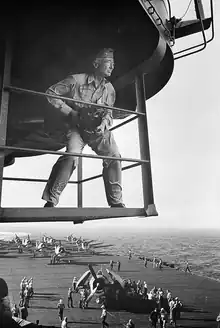
At the commencement of World War II, Steichen, then in his sixties, had retired[36] as a full-time photographer. He was developing new varieties of delphinium, which in 1936 had been the subject of his first exhibition at the Museum of Modern Art, and the only flower exhibition ever held there.
When the United States joined the global conflict, Steichen, who had come out of the first World War an Army Colonel, was refused for active service because of his age.[37] Later, invited by the Navy to serve as Director of the Naval Aviation Photographic Unit,[38][39][40] he was commissioned a Lieutenant-Commander in January 1942. Steichen selected for his unit six officer-photographers from the industry (sometimes irreverently called "Steichen's chickens"), including photographers Wayne Miller and Charles Fenno Jacobs.[41] A collection of 172 silver gelatin photographs taken by the Unit under his leadership is held at the Harry Ransom Center at the University of Texas at Austin.[36] Their war documentary The Fighting Lady, directed by Steichen, won the Academy Award for Best Documentary Feature at the 17th Academy Awards.
In 1942, Steichen curated for the Museum of Modern Art the exhibition Road to Victory, five duplicates of which toured the world. Photographs in the exhibition were credited to enlisted members of the Navy, Coast Guard, and Marine Corps and numbers by Steichen's unit, while many were anonymous and some were made by automatic cameras in Navy planes operated while firing at the enemy.[42] This was followed in January 1945 by Power in the Pacific: Battle Photographs of our Navy in Action on the Sea and In the Sky.[43] Steichen was released from Active Duty (under honorable conditions) on December 13, 1945, at the rank of Captain. For his service during World War II, he was awarded the World War II Victory Medal, Asiatic-Pacific Campaign Medal (with 2 campaign stars), American Campaign Medal, and numerous other awards.
Museum of Modern Art

In the summer of 1929, Museum of Modern Art director Alfred H. Barr, Jr. had included a department devoted to photography in a plan presented to the Trustees. Though not put in place until 1940, it became the first department of photography in a museum devoted to twentieth-century art and was headed by Beaumont Newhall. On the strength of attendances of his propaganda exhibitions Road to Victory[44] and Power in the Pacific, and precipitating curator Newhall's resignation along with most of his staff, in 1947 Steichen was appointed Director of Photography until 1962, later assisted by Grace M. Mayer.
His appointment was protested by many who saw him as anti-art photography, one of the most vocal being Ansel Adams who on April 29, 1946, wrote a letter to Stephen Clark (copied to Newhall) to express his disappointment over Steichen's hiring for the new position of director; “To supplant Beaumont Newhall, who has made such a great contribution to the art through his vast knowledge and sympathy for the medium, with a regime which is inevitably favorable to the spectacular and 'popular' is indeed a body blow to the progress of creative photography.”[45]
Nevertheless, Ansel Adams' image Moonrise, Hernandez, New Mexico was first published in U.S. Camera Annual 1943, after being selected by Steichen, who was serving as judge for the publication.[46] This gave Moonrise an audience before its first formal exhibition at the Museum of Modern Art in 1944.[47]
Steichen as director held a strong belief in the local product, of the "liveness of the melting pot of American photography,’’ and worked to expand and organise the collection, inspiring and recognising the 1950s generation while keeping historical shows to a minimum. He worked with Robert Frank even before his The Americans was published, exhibited the early work of Harry Callahan and Aaron Siskind, and purchased two Rauschenberg prints in 1952, ahead of any museum.[48] Steichen also kept international developments in his scope and held shows and made important acquisitions from Europe and Latin America, occasionally visiting those countries to do so. Three books were published by the Department during his tenure (The Family of Man, Steichen the Photographer, and The Bitter Years: 1935–1941: Rural America as Seen by the Photographers of the Farm Security Administration).[49][48] Despite his solid career in photography, Steichen displayed his own work at MoMA—his retrospective, Steichen the Photographer—only after he had already announced his retirement in 1961.
Among accomplishments that were to redeem initial resentment at his appointment, Steichen created The Family of Man, a world-touring Museum of Modern Art exhibition that, while arguably a product of American Cold War propaganda, was seen by 9 million visitors and still holds the record for most-visited photography exhibit. Now permanently housed and on continuous display in Clervaux (Luxembourgish: Klierf) Castle in northern Luxembourg, his country of birth, Steichen regarded the exhibition as the "culmination of his career.".[50] Comprising over 500 photos that depicted life, love and death in 68 countries, the prologue for its widely purchased catalogue was written by Steichen's brother-in-law, Carl Sandburg.[51] As had been Steichen's wish, the exhibition was donated to the Grand Duchy of Luxembourg, his country of birth.
MoMA exhibitions curated or directed by Steichen
The following are exhibitions curated or directed by Steichen during his tenure as Director of Photography at The Museum of Modern Art:
- 1947: Three Young Photographers: Leonard McCombe, Wayne F. Miller, Homer Page, September 30–December 7[52]
- 1948: In and Out of Focus: A Survey of Today's Photography. “A survey of photography today, including prints by 76 photographers from many parts of the country, the first large exhibition organized by Captain Edward J. Steichen, Director of the Museum's Department of Photography”, April 6–July 11 [53]
- 1948: 50 Photographs by 50 Photographers. “50 prints from the Museum Collections that form an abbreviated history of the development of pictorial photography during the past 100 years.” July 27–September 26[54]
- 1948: Photo-Secession (American Photography 1902–1910), September 29–November 28[55]
- 1948/1949 Photographs by Bill Brandt, Harry Callahan, Ted Croner, Lisette Model, November 30, 1948–February 10[56]
- 1949: This Exact Instant, Events And Pages in 100 Years of News Photography, February 8–May 1[57]
- 1949: Roots of Photography, comprising works by Hill and Adamson, Julia Margaret Cameron and Henry Fox Talbot, April 26–July 24[58]
- 1949: Realism in Photography. Works by Ralph Steiner, Wayne F. Miller, Tosh Matsumoto, Frederick Sommer, July 26–September 25[59]
- 1949: Photographs by Margaret Bourke-White, Helen Levitt, Dorothea Lange, Tana Hoban, Esther Bubley, and Hazel-Frieda Larsen. “Sixty prints by 6 women photographers” October 11–November 15[60]
- 1950: Roots of French Photography, November 29, 1949–January 15[61]
- 1950: Photographs of Picasso by Gjon Mili and by Robert Capa, January 24–March 19,
- 1950: Photography Recent Acquisitions: Stieglitz, Atget, March 28–May 7,
- 1950: Color Photography, May 9–July 4,
- 1950: Photographs by 51 Photographers, August 1–September 17,
- 1950: Photographs by Lewis Carroll, September 26–December 3,
- 1951: Korea - The Impact of War in Photographs, February 13–April 22,
- 1951: Abstraction in Photography, May 1–July 4,
- 1951: 12 Photographers, July 12–August 12,
- 1951: Forgotten Photographers, August 23–November 4,
- 1951: Memorable 'Life' Photographs, November 20–December 12,
- 1952: Christmas Photographs, November 29, 1951–January 6,
- 1952: Five French Photographers, December 18, 1951–February 24,
- 1952: We Create for Pleasure, January 23–March 2,
- 1952: Diogenes with a Camera, May 20–September 1,
- 1952: Then and Now, August 5–18,
- 1953: Always the Young Strangers, February 26–April 1,
- 1953: Postwar European Photography, May 26–August 23,
- 1955: The Family of Man, January 24–May 8,[62][63][51]
- 1956: Diogenes with a Camera III, January 17–March 18,
- 1956: Diogenes with a Camera IV, April 4–June 3,
- 1956/7: Language of the Wall: Parisian Graffiti Photographed by Brassaï, October 24, 1956 – January 13, 1957
- 1958: 70 Photographers Look at New York, November 27, 1957–April 15, in collaboration with Grace Mayer
- 1959: Photographs from the Museum Collection, November 26, 1958–January 18,
- 1960: Photographs for Collectors, October 1–16, “Photographs for Collectors, more than 250 prints by 66 photographers…priced at $25 and up, in color or in black and white, some framed for hanging. Styles range from photo-journalism to abstraction…and…familiar classics of photography[64]
- 1962: Photographs by Harry Callahan and Robert Frank, January 30–April 1[65]
- 1962: 50 Photographs by 50 Photographers, April 3–May 15,
- 1962: The Bitter Years: 1935–1941, October 18–November 25, selected by Steichen (described in the press release as ‘Director Emeritus’) from 270,000 taken for the F.S.A., assisted by picture researcher Davis Pratt for an installation designed by Kathleen Haven.[66]
In the latter years of his tenure after her appointment by Steichen as Assistant Curator, it was Grace Mayer, 'overseen' by Steichen, who selected and organized the shows Recent Acquisitions (December 21, 1960 – February 5, 1961), 1960: The Sense of Abstraction, February 17–April 10,[67] Steichen the Photographer (March 28–May 30, 1961), A Bid For Space (4 installations, 1960 to 1963), Diogenes with a Camera V (September 26–November 12, 1961), and Walker Evans: American Photographs (June 8, 1962 – February 14, 1963).
Steichen hired John Szarkowski to be his successor at the Museum of Modern Art on July 1, 1962. On his appointment, Szarkowski promoted Mayer to Curator.
Later life
On December 6, 1963, Steichen was presented with the Presidential Medal of Freedom by U.S. President Lyndon B. Johnson.[68]
Though then 88 years old and unable to attend in person, in 1967 Steichen, as a still-active member of the copyright committee of the American Society of Magazine Photographers, wrote a submission to the U.S. Senate hearings to support copyright law revisions, requesting that "this young giant among the visual arts be given equal rights by having its peculiar problems taken into account."[69]
In 1968, the Edward Steichen Archive was established in MoMA's Department of Photography. The Museum's then-Director René d’Harnoncourt declared that its function was to "amplify and clarify the meaning of Steichen’s contribution to the art of photography, and to modern art generally.”[28] Creator of the Archive was Grace M. Mayer, who in 1959 started her career as an assistant to the director, Steichen, and who became Curator of Photography in 1962, retiring in 1968. Mayer returned after her retirement to serve in a voluntary capacity as Curator of the Edward Steichen Archive until the mid-1980s to source materials by, about, and related to Steichen. Her detailed card catalogs are housed in the Museum's Grace M. Mayer Papers.[70]
Steichen's 90th birthday was marked with a dinner gathering of photographers, editors, writers, and museum professionals at the Plaza Hotel in 1969. The event was hosted by MoMA trustee Henry Allen Moe, and U.S. Camera magazine publisher Tom Maloney.[28]
In 1970, an evening show was presented in Arles during The Rencontres d'Arles festival: "Edward Steichen, photographe" by Martin Boschet.
Steichen bought a farm that he called Umpawaug in 1928, just outside West Redding, Connecticut.[71] He lived there until his death on March 25, 1973, two days before his 94th birthday.[72] After his death, Steichen's farm was made into a park, known as Topstone Park.[73] As of 2018, Topstone Park was open seasonally.[74]
In 1974, Steichen was posthumously inducted into the International Photography Hall of Fame and Museum.[3]
Legacy
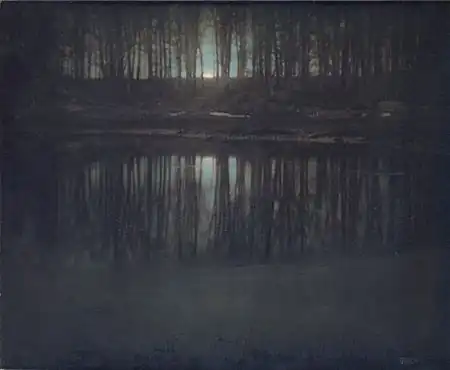
"I consider Steichen a very great artist and the leading, the greatest photographer of the time. Before him, nothing conclusive had been achieved."[75]
Steichen's career, especially his activities at MoMA, did much to popularise and promote the medium, and both before and since his death photography, including his own, continued to appreciate as a collectible art form.[48]
In February 2006, a print of Steichen's early pictorialist photograph, The Pond—Moonlight (1904), sold for what was then the highest price ever paid for a photograph at auction, US$2.9 million.
Steichen took the photograph in Mamaroneck, New York, near the home of his friend, art critic Charles Caffin. It shows a wooded area and pond, with moonlight appearing between the trees and reflecting on the pond. While the print appears to be a color photograph, the first true color photographic process, the autochrome process, was not available until 1907. Steichen created the impression of color by manually applying layers of light-sensitive gums to the paper. Only three prints of the Pond—Moonlight are still known to exist and, as a result of the hand-layering of the gums, each is unique. (The two prints not auctioned are held in museum collections.) The extraordinary sale price of the print is in part attributable to its one-of-a-kind character and to its rarity.[76]
A show of early color photographs by Steichen was held at the Mudam (Musée d'Art moderne) in Luxembourg City from July 14 to September 3, 2007.[77]
Personal life
Steichen married Clara E. Smith (1875–1952) in 1903. They had two daughters, Mary Rose Steichen (1904-1998) and Charlotte "Kate" Rodina Steichen (1908-1988). In 1914, Clara accused her husband of having an affair with artist Marion H. Beckett, who was staying with them in France. The Steichens left France just ahead of invading German troops. In 1915, Clara Steichen returned to France with her daughter Kate, staying in their house in the Marne in spite of the war. Steichen returned to France with the Photography Division of the American Army Signal Corps in 1917, whereupon Clara returned to the United States. In 1919, Clara Steichen sued Marion Beckett for having an affair with her husband, but was unable to prove her claims.[78][79] Clara and Edward Steichen eventually divorced in 1922.
Steichen married Dana Desboro Glover in 1923. She died of leukemia in 1957.
In 1960, aged 80, Steichen married 27-year-old Joanna Taub and remained married to her until his death, two days before his 94th birthday. Joanna Steichen died on July 24, 2010, in Montauk, New York, aged 77.[80]
Exhibitions
Solo
- 1900 Photo Club. Paris[81]
- 1900 Mrs. Arthur Robinson Home. Milwaukee (USA)[81]
- 1901 La Maison des Artistes, Paris[81]
- 1902 Photo-Club, Paris[81]
- 1902 Eduard Steichen, Paintings and Photographs; Maison des artistes; Paris, France[81]
- 1905 Photo-Secession Gallery, New York[81]
- 1906 Photographs by Eduard Steichen; Little Galleries of the Photo-Secession (291 Gallery); New York, New York[48]
- 1908 Eduard Steichen, Photographs in Monochrome and Color; Little Galleries of the Photo-Secession; New York, New York[48]
- 1909 Photo-Secession Gallery, New York[81]
- 1910 Photo-Secession Gallery, New York[81]
- 1910 Montross Gallery. London[81]
- 1910 Little Gallery. New York City (USA)[81]
- 1915 M. Knoedler & Company, New York (USA)[81]
- 1938 Museum of Modern Art, New York ( USA )[81]
- 1938 Edward Steichen; Baltimore Museum of Art; Baltimore, Maryland[48]
- 1938 Retrospective, Baltimore Museum of Art (USA)[81]
- 1950 Edward Steichen, Retrospective; American Institute of Architects Headquarters; Washington, D.C.[48]
- 1961 Steichen the Photographer; Museum of Modern Art; New York, New York[81]
- 1965 Retrospective, Bibliothèque Nationale, Paris[81]
- 1976 Allan Frumkin Gallery. Chicago (USA)[81]
- 1978 Museum of Modern Art. New York (USA)[81]
- 1979 George Eastman House, Rochester ( USA)[81]
- 2000 Edward Steichen; Whitney Museum of American Art; New York, New York[48][82][83]
- 2002 Edward Steichen: Art as Advertising/ Advertising as Art; Norsk Museum for Fotografi-Preus Fotomuseum; Horten, Norway[48]
- 2004: Hollywood Celebrities: Edward Steichen, Kunsthal Rotterdam, Netherlands, 17 Jan – 25 Apr[84]
- 2005: Edward Steichen, Botschaft von Luxemburg, Germany, 22 Apr – 21 May[85]
- 2005: Hollywood Celebrity: Edward Steichen’s Vanity Fair Portraits, Multimedia Art Museum, Russia, 14 Mar – 14 May[86]
- 2007: Steichen; une épopée photographique, Jeu de Paume, France, 9 Oct – 30 Dec[87]
- 2008: Edward Steichen, Palazzo Magnani, Italy, 30 Apr – 8 Jun[88]
- 2008: Edward Steichen: Lives in Photography / Une épopée photographique, Musée de l'Elysée, Switzerland, 18 Jan – 24 Mar[89]
- 2008: Edward Steichen: Une Epopée Photographique, Museo Nacional Centro de Arte Reina Sofia, Spain, 25 Jun – 22 Sep[90]
- 2008 Edward Steichen: In High Fashion 1923-1937, Kunsthaus Zürich, Switzerland, 11 Jan – 30 Mar
- 2009: Edward Steichen: 1915-1923, Howard Greenberg Gallery, USA, 20 Mar – 16 May
- 2009: Edward Steichen: In High Fashion, Kunstmuseum Wolfsburg, Germany, 11 Oct 2008 – 2 Jan
- 2009: Edward Steichen: In High Fashion the Condé Nast Years, 1923–1937, Williams College Museum of Art, USA, 6 Jun – 8 Nov
- 2009: Edward Steichen: In High Fashion, The Condé Nast Years, 1923–1937, International Center of Photography, USA, 16 Jan – 3 May
- 2009: Edward Steichen: The Early Years, Museum of Photographic Arts, USA, 31 Jan – 17 May
- 2009/10: Edward Steichen. In High Fashion, the Condé Nast Years, 1923–1937, AGO Art Gallery Ontario, Canada, Canada, 26 Sep 2009 – 3 Jan 2010
- 2011: Edward Steichen: Celebrity Design, Museum Folkwang, Germany, 6 Nov 2010 – 16 Jan
- 2011: Edward Steichen: The Last Printing, Danziger Gallery, USA, 15 Sep – 29 Oct
- 2012: Edward Steichen: gli anni Condé Nast, Fondazione Sozzani, Italy, 20 Nov 2011 – 12 Feb
- 2013: Edward Steichen, Museum of Photography, Denmark, 12 Oct 2012 – 9 Feb
- 2013: In High Fashion: the Condé Nast Years, 1923–1937, foam Fotografiemuseum Netherlands, 28 Jun – 6 Sep
- 2013: Modern Age Light and Shadow: 1923-1937, Setagaya Art Museum, Japan, 26 Jan – 7 Apr
- 2013: Talk of the Town: Portraits by Edward Steichen from the Hollander Collection, LACMA Museum, USA, 3 Aug – 8 Dec
- 2014: Sharp, Clear Pictures. Edward Steichen's World War I and Condé Nast Years, Art Institute of Chicago, USA, 28 Jun – 28 Sep
- 2014: Edward Steichen & Art Deco Fashion, National Gallery of Victoria, Australia, 18 Oct 2013 – 2 Mar
- 2014: Steichen in the 1920s and 1930s: A Recent Acquisition, Whitney Museum Art, USA, 6 Dec 2013 – 1 Aug
- 2014/ 2015: In High Fashion: Edward Steichen, The Conde Nast Years 1923 - 1937, Photographers' Gallery UK, 31 Oct 2014 – 18 Jan 2015
- 2015: Edward Steichen, Galerie Clairefontaine, Luxembourg, 8 Sep – 17 Oct[91]
- 2015: Edward Steichen In High Fashion. The Condé Nast Years. 1923-1937, Multimedia Art Museum, Russia, 9 Sep – 22 Nov
- 2015: In High Fashion: Edward Steichen, WestLicht, Austria, 18 Feb – 24 May
- 2016 Making Meaning of a Legacy: Edward Steichen, Centre for Fine Arts - Bozar, Belgium, 13 Nov 2015 – 5 Jan
- 2017: Twentieth-Century Photographer Edward Steichen, DeCordova Museum, US, 7 Oct 2016 – 26 Mar
Group
- 1900 The New School of American Photography; Royal Photographic Society; London, England and Paris, France[81]
- 1902 American Pictorial Photography; National Arts Club; New York, New York.[48]
- 1904 Salon International de Photographie, Paris.[81]
- 1905 Opening Exhibition; Little Galleries of the Photo Secession; New York, New York.[48]
- 1906 Photographs Arranged by the Photo Secession; Pennsylvania Academy of Fine Arts; Philadelphia, Pennsylvania[48]
- 1910 The Younger American Painters; Little Galleries of the Photo-Secession; New York, New York.[48]
- 1910 International Exhibit of Pictorial Photography; Albright Art Gallery; Rochester, New York[48]
- 1932 Murals by American Painters and Photographers; Museum of Modern Art; New York, New York[48]
- 1955 The Family of Man, MOMA, New York (USA)[81]
Bibliography
- Steichen, Edward (1955). The Family of Man: The Greatest Photographic Exhibition of All Time. New York: Maco Pub. Co for the Museum of Modern Art.
- Sandburg, Carl; Steichen, Edward, 1879-1973; Museum of Modern Art (New York, N.Y.) (1961), Steichen the photographer, Museum of Modern Art : distributed by Doubleday
{{citation}}: CS1 maint: multiple names: authors list (link) - Steichen, Edward (1963), A life in photography, Allen
- Steichen, Edward; Longwell, Dennis; Museum of Modern Art (New York, N.Y.) (1978), Steichen : the master prints 1895-1914, the symbolist period, Museum of Modern Art; Boston : distributed by New York Graphic Society, ISBN 978-0-87070-581-6
- DePietro, Anne Cohen (1985). The Paintings of Eduard Steichen. Huntington, NY: The Heckscher Museum. LCCN 85-80519 (Exhibition Catalog).
- Sandeen, Eric J. (1995). Picturing an Exhibition: The Family of Man and 1950's America. University of New Mexico Press.
- Steichen, Edward, 1879-1973; Gedrim, Ronald (1996), Edward Steichen : selected texts and bibliography, Clio Press, ISBN 978-1-85109-208-6
{{citation}}: CS1 maint: multiple names: authors list (link) - Steichen, Edward; Cortese, Sabina; Photographic Society of Great Britain (1997), Edward Steichen : the Royal Photographic Society collection, Charta, ISBN 978-88-8158-105-4
- Johnston, Patricia A; Steichen, Edward, 1879-1973 (1997), Real fantasies : Edward Steichen's advertising photography, University of California Press, ISBN 978-0-520-22707-1
{{citation}}: CS1 maint: multiple names: authors list (link) - Niven, Penelope (1997). Steichen: A Biography. New York: Clarkson Potter. ISBN 0-517-59373-4.
- Smith, Joel (1999). Edward Steichen: The Early Years. Princeton, NJ: Princeton University Press.
- Steichen, Edward; Steichen, Joanna T (2000), Steichen's legacy : photographs, 1895-1973 (1st ed.), Alfred A. Knopf, ISBN 978-0-679-45076-4
- Haskell, Barbara (2000). Edward Steichen. New York: Whitney Museum of American Art.
- Steichen, Edward; Bjerke, Øivind Storm, 1953-; Norsk museum for fotografi--Preus fotomuseum (2002), Edward Steichen : art as advertising, advertising as art : works from the collection of Norsk museum for fotografi - Preus fotomuseum, Norsk museum for fotografi - Preus fotomuseum
{{citation}}: CS1 maint: multiple names: authors list (link) - DePietro, Anne Cohen; Goley, Mary Anne (2003). Eduard Steichen: Four Paintings in Context.Hollis Taggart Galleries.
- Mitchell, Emily (2007). The Last Summer of the World. Norton. (A fictional narrative about Steichen.)
- Steichen, Edward, 1879-1973; George Eastman House; Musée d'art moderne Grand-Duc Jean (2007), Bloom! : experiments in color photography by Edward Steichen : a selection from George Eastman House, International Museum of Photography and Film, Musée d'Art Moderne Grand-Duc Jean, ISBN 978-2-919873-02-9
{{citation}}: CS1 maint: multiple names: authors list (link) - Martineau, Paul, 1967-; J. Paul Getty Museum, eds. (2018), Icons of style : A Century of Fashion Photography, The J. Paul Getty Museum, ISBN 978-1-60606-558-7
{{citation}}: CS1 maint: multiple names: editors list (link)
Gallery
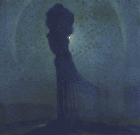 Landscape with Avenue of Trees, a painting by Steichen, 1902
Landscape with Avenue of Trees, a painting by Steichen, 1902 Portrait of Auguste Rodin by Steichen, 1902
Portrait of Auguste Rodin by Steichen, 1902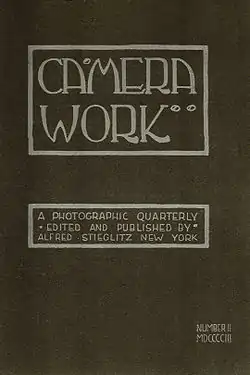 The cover of Camera Work, showing Steichen's design and custom typeface. Also, in this specific issue, Issue 2, the entire volume was devoted to Steichen's photographs.
The cover of Camera Work, showing Steichen's design and custom typeface. Also, in this specific issue, Issue 2, the entire volume was devoted to Steichen's photographs.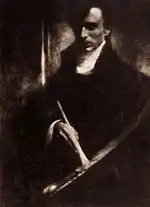 Self-portrait, by Edward Steichen. Published in Camera Work No 2, 1903
Self-portrait, by Edward Steichen. Published in Camera Work No 2, 1903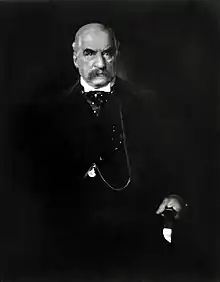 Portrait of J.P. Morgan, taken in 1903
Portrait of J.P. Morgan, taken in 1903 The Flatiron in a photograph of 1904, taken by Steichen
The Flatiron in a photograph of 1904, taken by Steichen Experiment in Three-Color Photography, by Steichen, published in Camera Work No 15, 1906
Experiment in Three-Color Photography, by Steichen, published in Camera Work No 15, 1906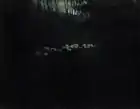 Pastoral – Moonlight, by Steichen, published in Camera Work No 20, 1907
Pastoral – Moonlight, by Steichen, published in Camera Work No 20, 1907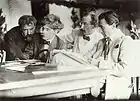 Eugene, Stieglitz, Kühn and Steichen Admiring the Work of Eugene, by Frank Eugene from 1907. From left to right are Eugene, Alfred Stieglitz, Heinrich Kühn, and Steichen.
Eugene, Stieglitz, Kühn and Steichen Admiring the Work of Eugene, by Frank Eugene from 1907. From left to right are Eugene, Alfred Stieglitz, Heinrich Kühn, and Steichen. Henri Matisse and La Serpentine, fall 1909, Issy-les-Moulineaux, photograph by Edward Steichen
Henri Matisse and La Serpentine, fall 1909, Issy-les-Moulineaux, photograph by Edward Steichen Picture by Steichen of Brâncuși's studio, 1920
Picture by Steichen of Brâncuși's studio, 1920 Portrait of Constantin Brâncuși, taken at Steichen's home & studio at Voulangis, in 1922
Portrait of Constantin Brâncuși, taken at Steichen's home & studio at Voulangis, in 1922 Wind Fire. Thérèse Duncan, the adopted daughter of Isadora Duncan, dancing at the Acropolis of Athens, 1921, by Steichen
Wind Fire. Thérèse Duncan, the adopted daughter of Isadora Duncan, dancing at the Acropolis of Athens, 1921, by Steichen
%252C_in_November_1943_(80-G-K-15290).jpg.webp) "Aircraft of Carrier Air Group 16 return to the USS Lexington (CV-16) during the Gilberts operation, November 1943." Photographed by Commander Edward Steichen, USNR.
"Aircraft of Carrier Air Group 16 return to the USS Lexington (CV-16) during the Gilberts operation, November 1943." Photographed by Commander Edward Steichen, USNR.
References
- "Edward Steichen Lives in Photography". Museo Reina Sofia. Retrieved 30 November 2020.
- Whitman, Aiden (26 March 1973). "Edward Steichen Is Dead at 93; Made Photography an Art Form". The New York Times. New York Times. Retrieved 30 November 2020.
- "Edward Steichen 1879-1973". International Photography Hall of Fame and Museum. Retrieved 30 November 2020.
- Gurría-Quintana, Ángel (16 November 2007). "Lightly across a lifetime of reinvention". Financial Times. Archived from the original on 2022-12-10. Retrieved 30 November 2020.
- "Edward Steichen". 1879.
- "Edward Steichen". International Center of Photography. 17 May 2019. Retrieved 30 November 2020.
- "Family of Man". UNESCO Memory of the World Programme. 2008-05-16. Archived from the original on 2010-02-25. Retrieved 2009-12-14.
- Roger Tooth, At $2.9m, Pond-Moonlight becomes world's most expensive photograph, The Guardian, February 15, 2006.
- Pogrebin, Robin (9 November 2022). "Paul G. Allen's Art at Christie's Tops $1.5 Billion, Cracking Records". New York Times. Retrieved 3 January 2023.
- Niven, Penelope (1997). Steichen: A Biography. New York: Clarkson Potter. ISBN 0-517-59373-4, p. 4
- "Lilian "Paula" Sandburg". National Park Service. Retrieved November 23, 2019.
- Niven, Penelope (1997). Steichen: A Biography. New York: Clarkson Potter. ISBN 0-517-59373-4, p. 6
- Niven, Penelope (1997). Steichen: A Biography. New York: Clarkson Potter. ISBN 0-517-59373-4, p. 16
- Elçi, Yasemin (October 2020). "From Bivange to Manhattan". Luxembourg Times. No. 6. Retrieved 3 January 2023.
- Faram, Mark D. Faces of War: The Untold Story of Edward Steichen's WWII Photographers Penguin, 2009; pp. 15-16
- Gedrim, Ronald J. (1996). Edward Steichen: Selected Texts and Bibliography Oxford, UK: Clio Press. ISBN 1-85109-208-0, p. xiii
- Niven (1997), p. 28
- Niven (1997), p. 29
- Niven (1997), p. 42
- "Edward Steichen". Retrieved 17 August 2022.
- Niven (1997), p. 66
- Niven, Penelope (1997). Steichen: A Biography. New York: Clarkson Potter. ISBN 0-517-59373-4, p. 74
- Niven (1997), p. 75
- Roberts, Pam (1997) "Alfred Stieglitz, 291 Gallery and Camera Work," contained in Stieglitz, Alfred (1997) Camera Work: The Complete Illustrations 1903–1917 Köln: Taschen. ISBN 3-8228-8072-8, p. 17
- Steichen, Edward, 1879-1973; George Eastman House; Musée d'art moderne Grand-Duc Jean (2007), Bloom! : experiments in color photography by Edward Steichen : a selection from George Eastman House, International Museum of Photography and Film, Musée d'Art Moderne Grand-Duc Jean, ISBN 978-2-919873-02-9
{{citation}}: CS1 maint: multiple names: authors list (link) - "Artist Info". www.nga.gov. Retrieved 2022-08-28.
- Ewing, William A. (2008). Edward Steichen. Penguin Random House. ISBN 9780500410936.
- "Edward Steichen Archive in The Museum of Modern Art Archives steichen". www.moma.org. Retrieved 2019-06-28.
- Aubenas, Sylvie; Séeberger, Henri, 1876-1947; Séeberger, Jules, 1872-1932; Séeberger, Louis, 1874-1956; Demange, Xavier; Chardin, Virginie; Bibliothèque nationale de France. Galerie de photographie (2006), Les Séeberger, photographes de l'élégance, 1909-1939, Seuil : Bibliothèque nationale de France, ISBN 978-2-7177-2366-3
{{citation}}: CS1 maint: multiple names: authors list (link) - Niven (1997), p. 352
- Steichen’s prints appeared in an article by Paul Cornu, 'L’art de la robe', in Art et Décoration, April 1911, 101-18
- Steichen, Edward. 'Experiment in Three-Color Photography' in 'Our lllustrations'. In Camera Work, no . 15 (July 1906): 44
- Steichen, Edward; Steichen, Joanna T (2010), Steichen in color : portraits, fashion & experiments, Sterling; Lewes : GMC Distribution [distributor], ISBN 978-1-4027-6000-6
- Martineau, Paul, ed. (2018), Icons of style : A Century of Fashion Photography, The J. Paul Getty Museum, p. 29, ISBN 978-1-60606-558-7
- Steichen, Edward (1963), A life in photography, Allen, p. facing plate 95
- Bristol, Horace; Jacobs, Fenno; Jorgensen, Victor; Kerlee, Charles E.; Miller, Wayne F.; Steichen, Edward; Unit (U.S.), Naval Aviation Photographic. "Edward Steichen An Inventory of His Naval Aviation Photographic Unit Photographs at the Harry Ransom Center". norman.hrc.utexas.edu. Retrieved 2019-06-27.
- Sandeen, Eric J (1995), Picturing an exhibition : the family of man and 1950s America (1st ed.), University of New Mexico Press, ISBN 978-0-8263-1558-8
- Steichen, Edward, 1879-1973; Phillips, Christopher; United States. Naval Aviation Photographic Unit (1981), Steichen at war, H.N. Abrams, ISBN 978-0-8109-1639-5
{{citation}}: CS1 maint: multiple names: authors list (link) - Steichen, Edward (1947), The Blue Ghost : a photographic log and personal narrative of the aircraft carrier U.S.S. Lexington in combat operation (1st ed.), Harcourt, Brace
- Budiansky, Stephen, "The Photographer who Took the Navy's Portrait", World War II, Volume 26, No. 2, July/August 2011, p. 25
- Faram, Mark D (2009), Faces of war : the untold story of Edward Steichen's WWII photographers (1st ed.), Berkley Caliber, ISBN 978-0-425-22140-2
- "Museum of Modern Art Press Release: Museum of Modern Art exhibits official photographs of Naval Sea and Air Action in the Pacific" (PDF).
- "Museum of Modern Art press release–'Edward Steichen appointed Head of Photography at Museum of Modern Art'" (PDF). July 15, 1947.
- Hill, Jason; Schwartz, Vanessa R; ebrary, Inc (2015), Getting the picture : the visual culture of the news, Bloomsbury Academic, ISBN 978-1-4725-6664-5
- Stegner, WallAce; Alinder, Mary Street; Stillman, Andrea G (2017), Ansel Adams--Letters, 1916--1984, [Place of publication not identified publisher not identified], ISBN 978-0-316-43699-1
- Alinder, Mary Street (1996). Ansel Adams: a Biography. New York: Henry Holt. ISBN 0-8050-5835-4, p. 192
- Alinder (1996), p. 193
- Warren, Lynne; Warren, Lynn (2005), Encyclopedia of Twentieth-Century Photography, 3-Volume Set, Taylor and Francis, p. 1106, ISBN 978-0-203-94338-0
- United States. Farm Security Administration; Steichen, Edward, 1879-1973; Steichen, Edward; Museum of Modern Art (New York) (1962), The Bitter Years: 1935–1941: Rural America as Seen by the Photographers of the Farm Security Administration, Museum of Modern Art : distributed by Doubleday and Co
{{citation}}: CS1 maint: multiple names: authors list (link)) - Dickie, Chris (2009), Photography : the 50 most influential photographers in the world, A & C Black, p. 117, ISBN 978-1-4081-0944-1
- Steichen, Edward; Sandburg, Carl, 1878–1967 (1955). The family of man : the photographic exhibition. Published for the Museum of Modern Art by Simon and Schuster in collaboration with the Maco Magazine Corporation.
{{cite book}}: CS1 maint: multiple names: authors list (link) - "Work of Three Young Photographers Exhibited by The Museum of Modern Art" (PDF). The Museum of Modern Art. Retrieved 3 January 2023.
- ""In and Out of Focus" Photography Show at The Museum of Modern Art" (PDF). The Museum of Modern Art. Retrieved 3 January 2023.
- "EXHIBITION OF 60 PHOTOGRAPHS BY 50 PHOTOGRAPHERS - LANDMARKS IN PHOTOGRAPHIC HISTORY" (PDF). The Museum of Modern Art. Retrieved 3 January 2023.
- "EXHIBITION OF WORK OF THE EARLY 20TH-CENTURY PHOTO SECESSION GROUP AND CAMERA WORK" (PDF). The Museum of Modern Art. Retrieved 3 January 2023.
- "PHOTOGRAPHS BY LISETTE MODEL, BILL BRANDT, TED CRONER AND HARRY CALLAHAN SHOWN IN MUSEUM EXHIBITION" (PDF). The Museum of Modern Art. Retrieved 3 January 2023.
- "THIS EXACT INSTANT, EVENTS AND PAGES IN 100 YEARS OF NEWS PHOTOGRAPHY" (PDF). The Museum of Modern Art. Retrieved 3 January 2023.
- "ROOTS OF PHOTOGRAPHY" (PDF). The Museum of Modern Art. Retrieved 3 January 2023.
- "FOUR PHASES IN PRESENT DAY PHOTOGRAPHY SHOWN IN MUSEUM EXHIBITION" (PDF). The Museum of Modern Art. Retrieved 3 January 2023.
- "PHOTOGRAPHS BY MARGARET B0URKE-WHITE, HELEN LEVITT, DOROTHEA LANGE, TANA HOBAN, ESTHER BUBLEY AND HAZEL FRIEDA LARSEN TO BE EXHIBITED" (PDF). The Museum of Modern Art. Retrieved 3 January 2023.
- "ROOTS OF FRENCH PHOTOGRAPHY" (PDF). The Museum of Modern Art. Retrieved 3 January 2023.
- "Museum of Modern Art. 'The Family of Man' Master Checklist" (PDF).
- "The Family of Man, Museum of Modern Art press release" (PDF).
- "Photographs for Collectors" (PDF). The Museum of Modern Art. Retrieved 3 January 2023.
- "PHOTOGRAPHS BY CALLAHAN AND FRANK AT MUSEUM OF MODERN ART" (PDF). The Museum of Modern Art. Retrieved 3 January 2023.
- "The Bitter Years,: 1935-l941" (PDF). The Museum of Modern Art. Retrieved 3 January 2023.
- "THE SENSE OF ABSTRACTION PHOTOGRAPHY SHOW AT MUSEUM OP MODERN ART" (PDF). The Museum of Modern Art. Retrieved 3 January 2023.
- "Artist Info".
- United States. (1967). Copyright law revision: Hearings before the Subcommittee on Patents, Trademarks, and Copyrights of the Committee on the Judiciary, United States Senate, Ninetieth Congress, first session pursuant to S. Res. 37 on S. 597., U.S. Government Printing Office
- "Grace M. Mayer Papers in The Museum of Modern Art". www.moma.org. Retrieved 2019-06-28.
- Niven (1997), p. 530
- Niven (1997), p. 698
- Prevost, Lisa, the New York Times, "An Upscale Town With Upcountry Style," 3 January 1999
- Town of Redding. "Town of Redding – Topstone Park". Townofreddingct.org. Retrieved 2019-02-10.
- Besson, George (October 1908). "Pictorial Photography: A Series of Interviews". Camera Work. 24: 14.
- "World | Americas | Rare photo sets $2.9m sale record". BBC News. February 15, 2006. Retrieved April 28, 2010.
- "Musée d'Art Moderne Grand-Duc Jean, Luxembourg, v3.0". Mudam.lu. Archived from the original on March 26, 2019. Retrieved April 28, 2010.
- "Artist's wife sues for loss of his love; Mrs. Eduard Steichen says Marion Beckett alienated her husband's affections. Asks for $200,000 damages; declares other woman followed the painter to Paris, where he was honored by France". The New York Times. July 5, 1919. Retrieved 25 February 2015.
- Mitchell, Emily (2007). The last summer of the world. New York: W.W. Norton. ISBN 978-0-393-06487-2. Retrieved 25 February 2015.
- Grimes, William (7 August 2010). "Joanna Steichen obituary". The New York Times. Retrieved 2012-12-18.
- Auer, Michèle; Auer, Michel (1985), Encyclopédie internationale des photographes de 1839 à nos jours = Photographers encyclopaedia international 1839 to the present, Editions Camera obscura, ISBN 978-2-903671-06-8
- "Jo Ann Lewis 'Edward Steichen, Examined Through An Unflattering Lens' Washington Post Archives, November 26, 2000". Washington Post. November 26, 2000. Retrieved June 29, 2019.
- "Hilton Kramer: 'Steichen's Sappy Photos Not Redeemed at Whitney'. Observer, New York, November 20, 2000". Observer. 2000-11-20. Retrieved 2019-06-29.
- "Exhibition Hollywood Celebrities - artist, news & exhibitions - photography-now.com". photography-now.com.
- "Edward Steichen Exhibition: 22 Apr – 21 May 2005 Luxemburgische Botschaft". photography-now.com. Retrieved 2019-06-29.
- "Exhibition Hollywood Celebrity: Edward Steichen's Vanity Fair Portraits - artist, news & exhibitions - photography-now.com". photography-now.com. Retrieved 2019-06-29.
- "Exhibition Steichen, une épopée photographique - artist, news & exhibitions - photography-now.com". photography-now.com. Retrieved 2019-06-29.
- "Edward Steichen Exhibition: 30 Apr – 8 Jun 2008, Palazzo Magnani". photography-now.com. Retrieved 2019-06-29.
- "Exhibition Lives in Photography / Une épopée photographique - artist, news & exhibitions - photography-now.com". photography-now.com. Retrieved 2019-06-29.
- "Edward Steichen, Une Epopée Photographique Exhibition: 25 Jun – 22 Sep 2008, Museo Nacional Centro de Arte Reina Sofia". photography-now.com. Retrieved 2019-06-29.
- "Exhibition Edward Steichen - artist, news & exhibitions - photography-now.com". photography-now.com. Retrieved 2019-06-29.
External links
| Library resources about Edward Steichen |
- Edward Steichen official website
- Works by Edward Steichen at the George Eastman Museum
- The Steichen Family Papers at the Beinecke Rare Book & Manuscript Library, Yale University
- Works by Edward Steichen - Oochens Series at the National Gallery of Art
- Steichen Collection at the Musée National d'Histoire et d'Art, Luxembourg
- The Family of Man at Clervaux Castle, Luxembourg
- Works by Edward Steichen - The Bitter Years at Waasertuerm Gallery, Luxembourg
- Carl Sandburg Home, North Carolina from the National Park Service
- Mary Steichen Calderone Papers at Schlesinger Library, Harvard University
- Rodin and Steichen at Musee Rodin
- Grace M. Mayer Papers at Museum of Modern Art
- Alfred Stieglitz Collection at The Metropolitan Museum of Art, New York
- Carl Sandburg Papers at University of Illinois
- American Expeditionary Force Photo Section (Steichen) Collection 1917-1919 at Smithsonian, National Air and Space Museum
- Edward J. Steichen World War II Navy Photographs Collection, 1941-1945 at Smithsonian, National Air and Space Museum
- Works by Edward Steichen at the International Center of Photography
- Alfred Stieglitz Collection at The Art Institute of Chicago
- —David Joseph (DJ) Marcou's cover-story Edward Steichen, HonFRPS: Renaissance Man in March 2004 RPS Journal, pp. 72–75.
- "From Luxembourg and America to the World: Edward Steichen's Photographic Legacy" at La Crosse History Unbound
- Works by Edward Steichen at the Museum of Modern Art